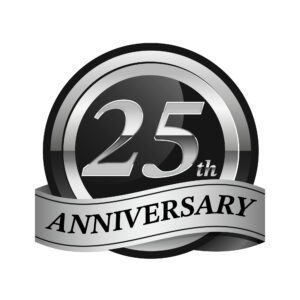For a quarter of a century now, our VR group has been researching the various possible applications of virtual reality (VR) at RWTH Aachen University.
We are celebrating – HAPPY BIRTHDAY!
How It All Began…
When individual RWTH institutes began to work on or with virtual reality at the end of the 1990s, it quickly became clear that high-quality research into VR technologies and methods was required. In autumn 1998, the Virtual Reality Group was founded by Professor Christian Bischof, then head of the Computing Center (now the IT Center) and Dr. Torsten Kuhlen, who moved from the Institute for Human-Machine Interaction to the Computing Center in this context.
Since then, the aim of the group has been to evaluate VR technology and to provide and optimize it for the simulation of complex scientific contexts. From the very beginning, the high number of collaborations with RWTH institutes from various faculties as well as companies and external research institutions testified to the great potential of this technology.
Thus, the use of VR was and is of great importance for a wide variety of scientific disciplines and enabled a correspondingly necessary personnel and machine infrastructure at RWTH early on.
Since its foundation, there have been two main areas of focus: application-driven research in the fields of virtual reality and immersive visualization and the development of VR technology for widespread use at RWTH Aachen University.
To deepen the associated scientific activities, the VR Group has also been involved as a teaching and research area “Virtual Reality and Immersive Visualization” in the Department of Computer Science at RWTH Aachen University since 2015 under the leadership of Prof. Dr. Torsten Kuhlen.
We Are Celebrating Our Silver Anniversary
The Virtual Reality Group (VRG) now operates one of the largest virtual reality labs in the world. The equipment ranges from small, desktop-like systems to the aixCAVE, a room projection that allows the interactive exploration of virtual worlds on a floor space of around 30 square meters. As the successor to the CAVE from 2004, the aixCAVE set an important milestone in 2012. It is a five-sided virtual reality installation for displaying immersive, virtual environments and can be used free of charge by any institute at RWTH Aachen University.
The aixCAVE is used in particular by numerous RWTH institutes and their cooperation partners from industry and academia.
The group has been and is involved in several projects of the German Research Foundation (DFG), the Federal Ministry of Education and Research (BMBF) and the European Union – in some cases as lead partner. The group is also involved in the National High Performance Computing Center for Computational Engineering Science (NHR4CES) and the Center for Simulation and Data Science of the Jülich Aachen Research Alliance (JARA-CSD).
With the emergence of low-cost, high-quality head-mounted displays and the subsequent renewed hype surrounding virtual and augmented reality, new opportunities are arising for the broad application of this technology. And not just in the entertainment industry, but also in research, teaching and industrial applications. Current work by the group to embed virtual characters in the form of agents or avatars in interaction with virtual environments, and finally the combination of virtual reality and artificial intelligence, hold out the prospect of completely new possibilities that until recently did not even seem conceivable.
Virtual Reality in Style
On September 19, 2023, the Aachener Zeitung reported on the ever-increasing enthusiasm for VR in society and interviewed Prof. Dr. Torsten Kuhlen about the range of research at the IT Center on VR.
You can read the full newspaper article, which focuses in particular on the VR games on offer in Aachen, with a subscription to the Aachener Zeitung.
Virtual Reality Services at the IT Center
A wide range of services is offered for RWTH institutes and local companies:
- Use of the VR Lab at the IT Center (aixCAVE, headset VR systems, visualization cluster)
- Use of our virtual reality integrations for Unity and the Unreal Engine
- Consulting and methodical support in the creation of (immersive) visualizations and VR applications
- Development of turnkey visualization and VR applications
- Advice on setting up the VR infrastructure at the institutes and chairs
- Collaboration in research projects with scientific questions relating to (immersive) visualization and virtual reality
If you have any questions, please contact the VR support team.
We look forward to many more exciting years and projects in the field of VR and to celebrating our golden anniversary in another 25 years!
Responsible for the content of this article is Dunja Gath, Prof. Dr. Torsten Kuhlen and Tanja Wittpoth-Richter.







